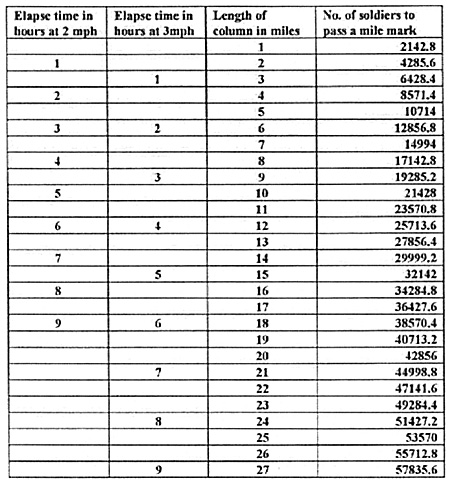Given these considerations, the rate of 3 miles per hour is highly optimistic and 2 miles per hour in the dark is far more probable. Once again, employing Delbruck's army corps as the basis of analysis with the numbers projected for the reported size of the Carthaginian force, the number of men per mile of column is determined.
 The chart shows the relationship of speed of a column, the lapse time, and the amount of troops which would pass a specified point whether that would be at the point where the head of the column begins or the clearance of the pass. Given that the entire period of darkness could be exploited as cited with Livy, at 2 mile per hour the Carthaginians could not pass the entire force accredited to them. Two and a half more hours would be required. Even then the last hours worth of march element would still be passing either the position of the original head of the column, obviously not through the pass, or it would be clearing the pass, but the head of the column would have had to be in the pass to begin with.
The chart shows the relationship of speed of a column, the lapse time, and the amount of troops which would pass a specified point whether that would be at the point where the head of the column begins or the clearance of the pass. Given that the entire period of darkness could be exploited as cited with Livy, at 2 mile per hour the Carthaginians could not pass the entire force accredited to them. Two and a half more hours would be required. Even then the last hours worth of march element would still be passing either the position of the original head of the column, obviously not through the pass, or it would be clearing the pass, but the head of the column would have had to be in the pass to begin with.
A Carthaginian army column of 50,000 would have had to maintain in the dark a very exceptional speed of 3 miles per hour. It would take nearly 8 hours for the column to proceed beyond a single point, sufficient within possible limits of the available darkness and the stipulations of both Livy and Polybios that the entire force did transit the pass. Given that the Celts, the least disciplined, would because of their position at the end of the column, the inheritors of any cascading delays, and would not depart the bivouac till many hours into the operation, this is highly questionable. Even then a remarkable maneuver at this late time is reported.
"...When daylight came, he saw the Romans drawn up and facing his light armed pikemen and sent up a contingent of Spaniards to reinforce them. The troops attacked the Romans, killed about 1,000 of them, easily rescued their own light armed troops, and brought them down to join the main body." [Polybios, Book III, 94]
Now we have the Spanish passing through the Celtic elements of the column to assault the Romans. To inflict a thousand Romans casualties, the Spanish contingent had to be of significant size well above a couple of hundred heads. If they remained in place before or after the pass to be readily available, the Spaniards would have had to occupy sufficient ground space to accommodate a 2 to 1 or 3 to 1 ratio above the Roman casualty figure. To remain in the area of the pass without sufficient space would only add to the congestion which only slows the rear of the column. If such space was not available in the immediate area then the Spaniards must indeed press back through the Celts, adding to the disorder and even delaying their ability to intervene. The other consideration is that the Carthaginian column was well clear of the pass and had sufficient room to redeploy the Spanish so as to permit them to provide relief to the light armed troops. That implies that the passage was quicker and the column much shorter, if the 1,000 Roman casualties is valid. Alternately, a significantly lower casualty figure would only require a smaller relief force. A smaller relief force could maneuver faster with less impact upon the rear elements of the overall column or occupy less terrain before or after the pass.
Overall, the numbers are not exact either in the record or the estimations. If Livy is accepted for the start of the movement, there is a level of probability on the numbers predicated upon optimal performance under challenging conditions. If Polybios is accepted for the start of the movement, the level of probability is low for the carthaginian numbers. In neither case did we go through the time dissipated for the execution of the oxen stratagem before the Carthaginian column would assemble and initiate movement. However, there is enough left to reasonably question that the issue will be further pursued, as was Hannibal's army.
More History of Logistics: Part One
History of Logistics: Part Two
-
Returning to the Scene of the Action
Sustaining an Army
Supply, Size, and Tactics
The Writing of History
Back to Strategikon Vol. 1 No. 2 Table of Contents
Back to Strategikon List of Issues
Back to MagWeb Master Magazine List
© Copyright 2001 by NMPI
This article appears in MagWeb (Magazine Web) on the Internet World Wide Web. Other military history articles and gaming articles are available at http://www.magweb.com